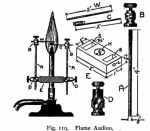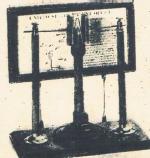
US_deForest-ORD
|
|
|||||||||||||||||||||||||||||||||||
|
Hits: 2601 Replies: 0
de Forest and the Flame Detector
|
|
|
Fin Stewart
14.May.17 |
1
This device is not a tube in the conventionaol sense. It is basically a Bunsen gas burner with metal rods stragetically placed above the burner mouth. In U. S. Patent No 979275 ( applied for on February 2nd, 1905 and granted on December 20th, 1920, this patent is headed "Oscillation Responsive Device". Various drawings are given. In the article on page 19 of Radio Craft magazine for January 1947, Lee de Forest summarises how he came to work with gas as a medium for detecting wireless currents. He was working in his bedroom in the summer of 1900 with the light from a Welsbach gas mantle lighting the room. He was working with his "Sponder" (an anti-coherer for the reception of wireless waves foruse in wireless telegraphy). He noticed that when he operated the key of his spark transmitter coil the light from the mantle would dim. When he stopped the key, the light would return to normal. He discovered that he could change light variations with the operation of the key. He "played" with his discovery for several weeks, believing that he had accidentally discovered that incandescent gases were affected by Hertzian waves.This, he reasoned, could well be a new princilpe which could be of value as a detector for wireless telegraphy. He and his assistant decided to put the transmitter in a closet and shut the door. Operation of the transmitter in the closet had no effect on the gas light. He was dissapointed with the result but still believed he had something which needed to be explored and also that this might involve a study of the physics of gases. . While working in a small laboratory at 11 Thames Street in Lower Manhattan in 1903, he had the time and opportunity to resume his experiments on the gas burner detector. He placed two platinum electrodes in the flame of a Bunsen burner and one electrode was connected through a telephone receiver to a dry battery (understood to have been a "number 6" 1.5 volt cell. And possibly a few of these connected in series to increase the voltage). From the battery, a wire was connected to the other platinum electrode. He enhanced the flame with sodium chloride (common salt). He found that, if the electrodes were properly located in the flame, he could hear signals from his spark transmitter through the telephone receiver. He proved his theory to be electrical, not acoustic, by connecting one electrode to an antenna and the other to the ground. He was able to receive signals from ships in New York Harbor. He made countless experiments with the device and believed he could improve the sensitivity of the detector, which in turn would increase thetransmission range. A legal problem occurred about this time and in a Law Suit instigated by the Marconi Company, de Forest was ordered "to forever desist from the manufacture, sale or operation of any system of Wireless Telegraph". This left him penniless but he still had the need for more experimenting. He leased a small laboratory in the Parker Building on the corner of Fourth Avenue and 19th Street where he started his renewed earch for a better wireless detector. He worked with the Bunsen burner as a main unit but designed several stands for holding or suspending the various but necessary electrodes. These atands had different means of operation and some were able to have the electrode holders moved up or down. In one of the later experiments, he introduced four electrodes into the flame. These were made of rings of slightly different circumferences so that each terminal coud snugly circle the flame. He also tried more chemicals to improve the performance. The main patent issued for the device was No 979275 issued in December 20th, 1910. It was applied for on February 1905. In the trials of these devices, de Forest was faced with a recurring problem - the flame could not be made to remain still. The slightest wind draft would affect the flame and sensitivity would be lost. In at least one experiment tried an open ended glass tube about 75-100 mm diameter, and 100 mm high to help shield the flame. This resulted in little improvement. In theory, his device worked but not in practice. He then decided to use an incandescent lamp, suitably modified, as a power source. In 1991 in Australia, Bob Pallett, an early member of the Historical Radio Society of Australia, made a replica of the flame detector. It had a small metylated spirit lamp in the central column and three posta carrying electrodes arranged around the flame. These posts are adjustable in height and can be rotated, allowing for a wide range in position of all electrodes. It would seem tthat Pallett had provided for investigation of triode capabilities of the device as well as diode action. A circuit diagram was also prepared showing suggested arrangements for the device. Bob Pallett unfortunately died shortly after he wrote an article for the HRSA Journal but this was rewritten by Ray Kelly, one of the HRSA founders, and was published in Vol.44, April 1993, pages 3 and 4. Pallett also made repklicas of other early wireless detecrtors.
References: 1) Radio Craft magazine January 1947, pages 19-22 2) saga of the vacuum Tube, G J Tyne, Howard W Sams 1977,pages 52-54 3) Historical Radio Society of Australia Journal, Vol 44, April 1993, pages 3 & 4
|
End of forum contributions about this tube
| Data Compliance | More Information |


